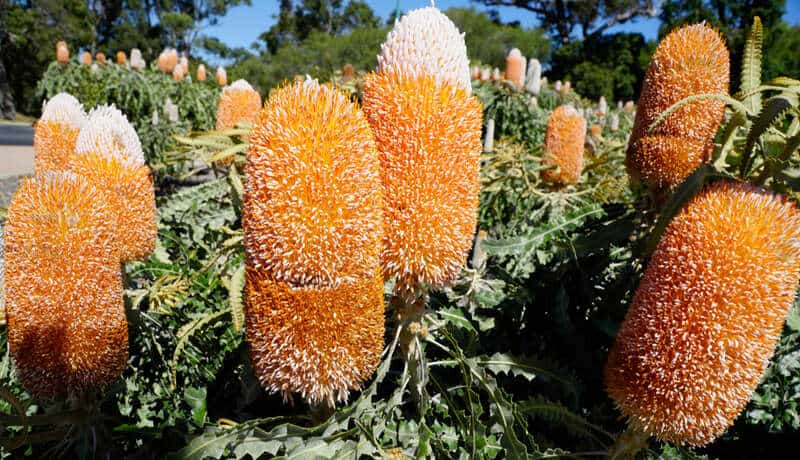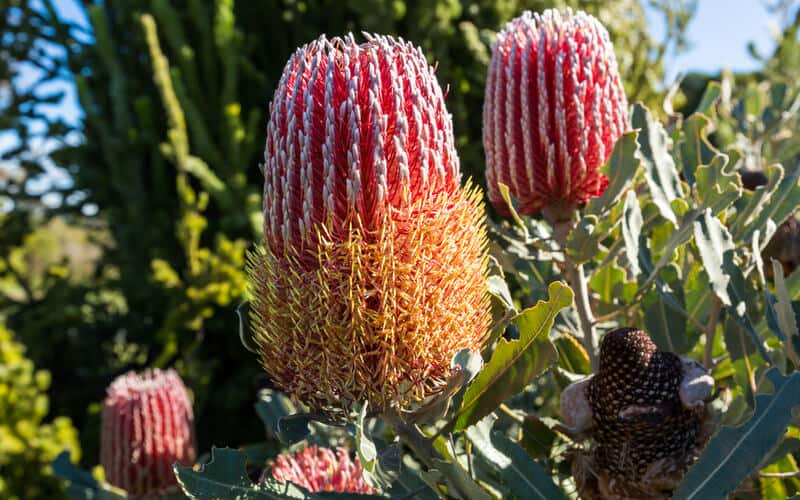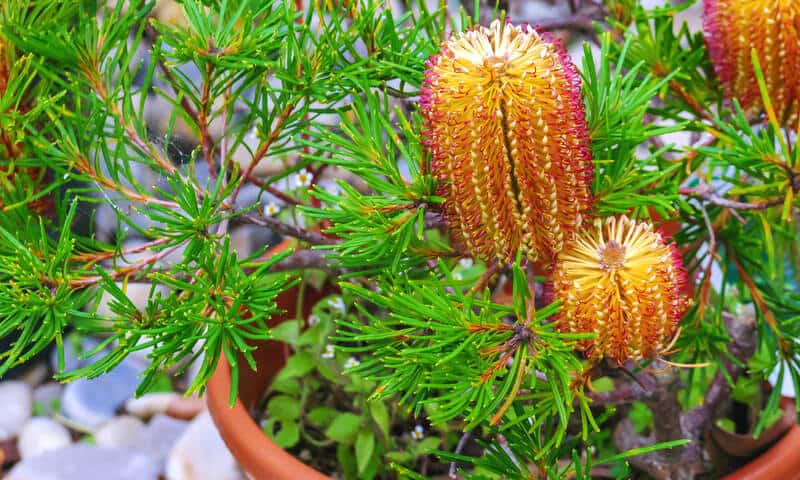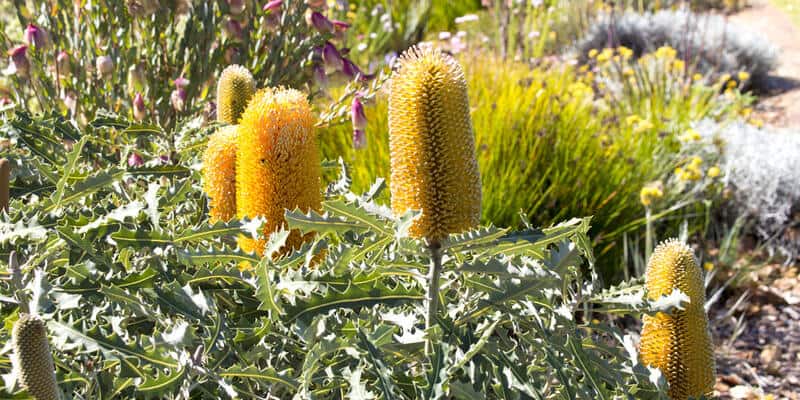From groundcover to shrubs to flourishing trees, banksia is a stunning and versatile plant to have in your garden.
It’s easily recognisable by its serrated leaves and its flower spikes, which come in greenish-white, yellow, and orange-red.
As Australian native plants, there are over 60 Banksia species alone in Western Australia, with even more in the eastern and northern states.
Banksia is simple enough to grow in your garden in any form. Plant it in a sunny location, and in sandy well-drained soil. Water regularly while germinating, but once established, banksia is drought tolerant. Then simply be patient while your banksia grows and — eventually — sprouts flower heads.
There are many Australian native trees that you can plant in your garden. But if you’re a fan of gorgeous flowers, here’s how to grow a banksia at home!
About Banksia
Banksia is an iconic Australian plant. It’s named after Sir Joseph Banks, who first recorded its discovery with Daniel Solander when they found it on the east coast of Australia in 1770.
There are now over 170 species of this native evergreen tree or shrub, which belongs to the protea family.
Banksia plants come in a variety of sizes, from low shrubs to 30m trees. Shrubs are either erect or prostrate, with stems along the ground; trees have a stout trunk and low branches.
The most recognisable aspects of a banksia are its serrated leaves and vividly coloured flower heads. These flower heads contain plenty of nectar, making them a prime attraction for bees and butterflies.
This nectar has long been eaten by indigenous Australians, whether sipped directly from the flower or soaked in water for a sweet drink.
As the flower heads dry up, they darken and transform into a woody ‘cone’. These contain the seeds, which are only released when the cone is burned or dried. The cone is sometimes used for crafts and woodwork.
Over 90% of banksia species are in Western Australia. The remainder are mostly in eastern Australia, with one species — Tropical Banksia — extending to New Guinea and the Aru Islands.
Growing Banksia

Location
Banksia are actually great to plant by pools and in gardens on the coast. The dwarf varieties are great groundcovers near or on courtyards and patios.
Larger varieties should be at least 4 metres away from structures and water lines or sewerage.
Soil
Like most plants, banksias like well drained soil. Go for a soil type that’s sandy and slightly acidic.
Light
Plant banksias somewhere with full sun, although they will tolerate partial shade.
Climate
Banksias prefer warm climates such as along the coast. Warm and cool temperate climates work well, as does Mediterranean-like weather. Once established, they’re able to tolerate light frost as well.
How To Grow A Banksia Tree

As trees
Commonly grown banksia trees include Banksia integrifolia or Coast Banksia; Banksia marginata or Silver Banksia; and Banksia serrata or Saw Banksia.
These species can grow to a height between 12m and 25m, although they rarely grow that tall in cultivated environments.
To grow a banksia in a garden, you’ll need to purchase a seedling or starter plant from your local nursery, then:
- Find a sunny spot in your garden — banksia loves sunlight. You can prep the ground beforehand with low-phosphorus mulch or compost. If your soil is clay or loam based, mix some gypsum well to improve drainage, or consider potting.
- Dig a hole to the same depth as the root ball, and twice as wide.
- Gently take the shrub from its container. Tease the roots carefully.
- Place your seedling in the hole and fill it up. Firm down the soil and water well. You can form a small, raised ring around the base to help guide the water down.
- Water regularly while your banksia is establishing — about once or twice a week. Once it’s established, water when the top layer of ground is dry.
As shrubs or groundcover
Banksia blechnifolia is one species of banksia that you can plant as ground cover. It’s actually a low-growing shrub, one of several Dwarf Banksia species.
Banksia spinulosa, or Birthday Candles, is another popular ground cover plant. Other great species include Banksia ericifolia or Heath Banksia, and Banksia aemula or Wallum Banksia.
To grow groundcover banksias, it’s best to purchase these as small plants from your local nursery.
Plant them somewhere with full sun, although they’ll tolerate partial shade. Dwarf banksias need well drained soil, but once established, they’re very drought tolerant.
As a potted plant

Make sure you choose a compact or dwarf variety if you want to grow banksias in a pot.
- Choose a spot in your home that gets plenty of sun — preferably near a window.
- Fill your pot with a well drained potting mix.
- Much like when planting in the garden, remove the plant carefully from the container.
- Position in the pot and backfill with more potting mix.
- Gently firm down the soil and water well. You can lightly mulch it if you want to.
Banksia Care
Fertilising
When fertilising banksias, it’s important not to use products high in phosphorus. Since banksia is a Proteaceae plant, it has developed proteid roots or ‘rootlet’ balls specialised for drawing nutrients from deficient soil. The Australian Native Plants Society recommends using fertilisers with an NPK (nitrogen:phosphorus:potassium) ratio of 10:3:6, or with less than 3% phosphorus.
Mulch is great for banksias and other native plants, since it breaks down slowly over time and gradually releases nutrients into the soil.
To make your own mulch, use organic matter like yard trimmings and pine bark, which is low in phosphorus.
Grass clippings and the like are best taken after mowing your lawn so they’re roughly shredded — so collect them in a bag yourself, or get a professional garden care service to maintain your garden and collect the clippings for you!
Make sure not to use mushroom-based mulch or compost — this will raise soil pH, which is bad for native Australian plants. Chicken manure is also inadvisable since it is high in phosphorus.

Watering
Banksia plants need regular watering while establishing — about once or twice a week.
Once they’re established, they’re fairly drought tolerant, so water only when the topsoil has dried out. Give them a spritz more often in the dry months so they don’t dehydrate.
Pruning
You can lightly prune the larger banksia tree varieties to keep them at a more manageable size.
Otherwise, just prune spent flower heads each year (‘deadheading’). You don’t want to over-prune, even for older stems, as this can affect the bloom of flowers.
Flowering
Banksia flowers from late summer through autumn, and often all the way to winter. Some banksias, such as Banksia ashbyi, can even flower in spring.
It may take a while, though — up to ten years — but seeing those pale yellow flowers against the green leaves is more than worth it.
So be patient with your banksia, give it plenty of love, and you’ll have a gorgeous ornamental plant in your garden for years to come.

